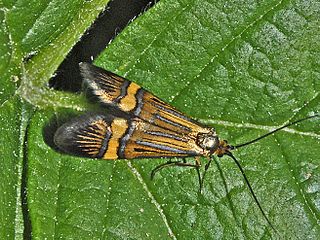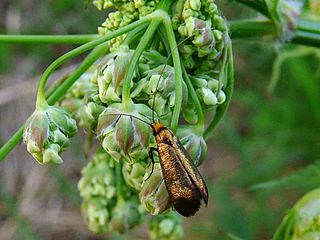
The Adelidae or fairy longhorn moths are a family of monotrysian moths in the lepidopteran infraorder Heteroneura. The family was first described by Charles Théophile Bruand d'Uzelle in 1851. Most species have at least partially metallic, patterned coloration and are diurnal, sometimes swarming around the tips of branches with an undulating flight. Others are crepuscular and have a drab coloration. Fairy longhorn moths have a wingspan of 4–28 millimeters, and males often have especially long antennae, 1–3 times as long as the forewing.

The longhorn moth or yellow-barred long-horn is a diurnal lepidopteran from the moths family Adelidae.

Archips podana, the large fruit-tree tortrix, is a moth of the family Tortricidae. The species was first described by Giovanni Antonio Scopoli in his 1763 Entomologia Carniolica. It is found in Europe, Asia from Anatolia to Japan and is an introduced species in North America.

Nematopogon swammerdamella is a moth of the family Adelidae.

Micropterix aureatella is a moth of the family Micropterigidae found in the Palearctic realm, except for North Africa.

Anacampsis populella is a moth of the family Gelechiidae, which is native to Europe and has been accidentally introduced to North America. It was first described in 1759 by Carl Alexander Clerck, a Swedish entomologist. The type specimen is from Sweden. The foodplants of the larvae are poplars and willows.

Adela croesella is a moth of the family Adelidae. It is found in most of Europe.

Acompsia cinerella, the ash-coloured sober, is a small lepidopteran species of the twirler moth family (Gelechiidae). It is the type species of the genus Acompsia, once assigned to the subfamily Anacampsinae but generally placed in the Dichomeridinae. The species was first described by Carl Alexander Clerck in 1759.

Nematopogon metaxella is a moth of the Adelidae family. It is found in most of Europe.

Cauchas is a genus of the fairy longhorn moth family (Adelidae). Among these, it belongs to subfamily Adelinae. The taxon "Cauchas" Philipp Christoph Zeller 1839 was originally created as a subgenus of the genus Adela Latreille 1796 but was raised to the genus level in 1980 by Ebbe Schmidt Nielsen.

Nemophora cupriacella is a moth of the family Adelidae that is found in most of Europe.

Heliozela resplendella is a moth of the Heliozelidae family. It is found from Fennoscandia and northern Russia to the Pyrenees, Alps and Romania and from Ireland to the Baltic region.

Aproaerema anthyllidella is a moth of the family Gelechiidae. It is found in most of Europe, Kyrgyzstan, Iran and North America.

Nemophora minimella is a moth of the Adelidae family. It is found in most of Europe, except Estonia, Ukraine, Slovenia, Switzerland and Portugal.
Nematopogon magna is a moth of the Adelidae family. It is found in Ireland, Great Britain, Denmark, Germany, Switzerland, Austria, Fennoscandia, the Baltic region and northern Russia.

Nematopogon pilella is a moth of the Adelidae family. It is found in almost all of Europe, except Portugal, Spain and Slovenia.

Nematopogon schwarziellus is a moth of the Adelidae family. It is found in almost all of Europe, except Portugal, Slovenia, Croatia, Greece and Ukraine.

Adela cuprella is a moth of the family Adelidae and are found in most of Europe. It was first described by Michael Denis & Ignaz Schiffermüller in 1775 and the type locality is from Austria. They can be found flying around sallows (Salix) species during the day in April and May.

Heliozela hammoniella is a moth of the Heliozelidae family. It is found in Ireland, Great Britain, the Netherlands, France, Germany, Austria, the Czech Republic, Poland, Romania, Lithuania, Latvia, Fennoscandia, and Russia.

Heliozela sericiella is a moth of the Heliozelidae family found in Europe. The larvae mine the twigs of oaks, causing a gall.


























